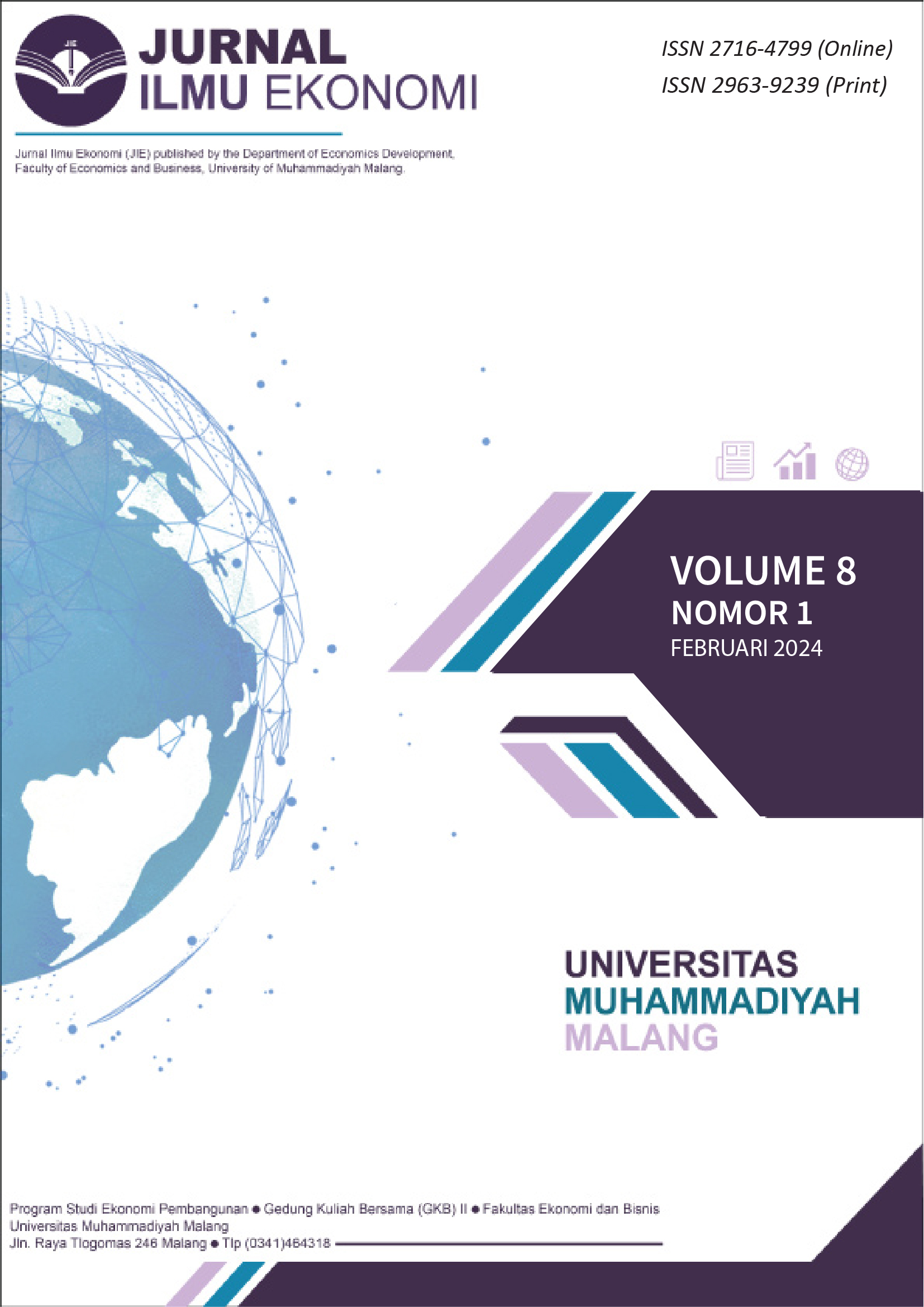Analisis Analisis Pengaruh Konsumsi Gula Nasional, Produksi Gula Nasional, Dan Jumlah Penduduk Indonesia Terhadap Jumlah Impor Gula Di Indonesia
DOI:
https://doi.org/10.22219/jie.v8i01.31767Keywords:
Production, consumption expenditure, Total PopulationAbstract
This research aims to determine the influence of national sugar consumption, national sugar production, and population in Indonesia on the amount of sugar imported. In this research, the data analysis techniques used are stationarity tests, regression tests, classical assumption tests, and statistical tests. The research results show that the national sugar consumption variable partially does not significantly and positively influence the amount of sugar imports. The federal sugar production variable has a powerful and negative impact on the amount of sugar imports. Meanwhile, the Indonesian population variable significantly influences the amount of sugar imports. The research results simultaneously or together with all independent variables (national sugar consumption, national sugar production, and population) significantly influence the dependent variable (amount of sugar imports).
Downloads
References
Agustin, S. E., Sugiyanta, S.-, & Rusmini, R.-. (2022). The Influence of Sugar Consumption and International Sugar Prices toward the Volume of Sugar Import in Indonesia. JOBS (Jurnal Of Business Studies), 7(1), 1. https://doi.org/10.32497/jobs.v7i1.3632
Andrie, B. M., & Novianty, A. (2021). Optimalisasi Pendapatan Petani Cabai Merah Dengan Diversifikasi Usahatani. Mimbar Agribisnis: Jurnal Pemikiran Masyarakat Ilmiah Berwawasan Agribisnis, 7(1), 254. https://doi.org/10.25157/ma.v7i1.4486
Aushaf, R., Juliprijanto, W., & Septiani, Y. (2020). Faktor-Faktor Yang Mempengaruhi Impor Gula di Indonesia Tahun 1989-2018. Directory Journal of Economic, 2(3), 700–716.
Dwipurwanti, R., & Sasana, H. (2022). Analisis Impor Gula Indonesia Tahun 2000-2019. Jurnal Ilmu Sosial, Manajemen, dan Akuntansi (JISMA), 1(2), 67–82.
Fafurida. (2012). Perencanaan Pengembangan Sektor Pertanian Sub Sektor Tanaman Pangan Di Kabupaten Kulonprogo. JEJAK: Jurnal Ekonomi dan Kebijakan, 2(2), 144–155.
Raharto, A. (2020). Penanggulangan Covid-19 Dalam Kerangka Teori Kependudukan Malthus. Jurnal Kependudukan Indonesia, 2902, 1. https://doi.org/10.14203/jki.v0i0.583
Rahayu, S. E. (2017). Analisis Perkembangan Impor Gula di Indonesia. Jurnal Kajian Ekonomi dan Kebijakan Publik, 2(2), 1–10.
Risyanto, H., & Mahdoh, M. (2018). Analisis Pengaruh Konsumsi Kedelai, Produksi Kedelai Dan Cadangan Devisa Terhadap Impor Kedelai Di Indonesia. I-ECONOMICS: A Research Journal on Islamic Economics, 4(2), 180–193. https://doi.org/10.19109/ieconomics.v4i2.2736
Rusdi, H., Priana Primandhana, W., & Wahed, M. (2021). Analisis Faktor yang Mempengaruhi Impor Gula Di Indonesia. Jurnal Syntax Admiration, 2(8), 1461–1479. https://doi.org/10.46799/jsa.v2i8.285
Saputra, I. K. E., & Swara, I. W. Y. (2012). PENGARUH PRODUKSI, KONSUMSI, HARGA ECERAN, INFLASI DAN KURS DOLLAR AS TERHADAP IMPOR GULA INDONESIA. 356–365.
Sartika, N. R., Amril, A., & Artis, D. (2018). Analisis determinan impor gula Indonesia dari Thailand. e-Journal Perdagangan Industri dan Moneter, 6(1), 1–13. https://doi.org/10.22437/pim.v6i1.4005
Suci, K., Husni Malian, D. A., Analisis, P., Ekonomi, S., Kebijakan, D., Bogor, P., Yani, J. A., & 70 Bogor, N. (2006). Perspektif Pengembangan Industri Gula Di Indonesia. 70, 1–20.
Sutanto, R. A., & Muljaningsih, S. (2022). Analisis faktor-faktor yang mempengaruhi impor gula di Indonesia. Kinerja, 19(1), 29–36. https://doi.org/10.30872/jkin.v19i1.10880
Taufani, A. (2020). DAMPAK IMPOR GULA TERHADAP PRODUKSI TEBU DAN HARGA GULA DOMESTIK DI INDONESIA. 5(2615), 35–48.
Zahraeni Kumalawati, B. B. M. (2015). ANALISIS EFEKTIFITAS DUA JENIS CENDAWAN MIKORIZA ARBUSKULA TERHADAP PERTUMBUHAN BIBIT TEBU (Saccharum officinarum L.). Agrokompleks, 14(Juni), 1–6.
Downloads
Published
How to Cite
Issue
Section
License
Copyright (c) 2024 Sania Ain Aulia

This work is licensed under a Creative Commons Attribution-NonCommercial-ShareAlike 4.0 International License.
Authors who publish with this journal agree to the following terms:
- For all articles published in the JIE (Jurnal Ilmu Ekonomi), copyright is retained by the authors. Authors give permission to the publisher to announce the work with conditions. When the manuscript is accepted for publication, the authors agree to the automatic transfer of non-exclusive publishing rights to the publisher.
- Authors retain copyright and grant the journal right of first publication with the work simultaneously licensed under a Creative Commons Attribution-NonCommercial-ShareAlike 4.0 International License that allows others to share the work with an acknowledgement of the work's authorship and initial publication in this journal.
- Authors are able to enter into separate, additional contractual arrangements for the non-exclusive distribution of the journal's published version of the work (e.g., post it to an institutional repository or publish it in a book), with an acknowledgement of its initial publication in this journal.
- Authors are permitted and encouraged to post their work online (e.g., in institutional repositories or on their website) prior to and during the submission process, as it can lead to productive exchanges, as well as earlier and greater citation of published work (See The Effect of Open Access).
This is an open access article and licensed under a Creative Commons Attribution-NonCommercial-ShareAlike 4.0 International License








